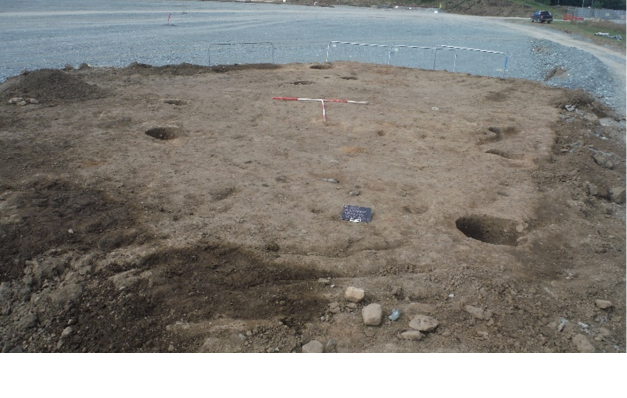2020:441 - BALLYBANE: Microsoft Campus. Grangecastle Business Park, Dublin
County: Dublin
Site name: BALLYBANE: Microsoft Campus. Grangecastle Business Park
Sites and Monuments Record No.: N/A
Licence number: 13E0471
Author: Neil O'Flanagan, Liam Coen & Chiara Mazzanti, Reliqua
Author/Organisation Address: Dublin Business Centre, 33 Slaney Road, Glasnevin, Dublin 11
Site type: Excavation - miscellaneous
Period/Dating: Prehistoric (12700 BC-AD 400)
ITM: E 703402m, N 731227m
Latitude, Longitude (decimal degrees): 53.321195, -6.447967
Renewed development in 2016 of the Microsoft Campus Data Centres DUB, 9, 10, 12, 13 in Grangecastle Business Park, Dublin, led to the excavation of several additional prehistoric sites between June-September 2016.
Neolithic:
DUB 12-13 Site 1 consisted of three stake-holes, a solitary pit, and a post-hole containing sherds of Early Neolithic pottery (Dunmurry-Ballymerlagh Type) of a likely date c. 3850–3750 BC. The micaceous nature of its clay suggested that its fabric originated in the Dublin/Wicklow mountains. Flint debitage was recovered in the post-hole.
DUB 12–13 Site 2 revealed a structure of likely Neolithic date. It comprised six irregularly spaced post-holes with several other pits and post-holes scattered around them. This substantial structure, probably a domestic house, had a maximum internal width of 9.15m east-west. The post-holes produced 38 sherds, from 14 vessels, from the Early Neolithic (Dunmurry–Ballymerlagh Type). They also produced numerous remnants of charred hazelnut shells, the nuts consumed as a foodstuff, and the shells disposed of in a fire. Stone implements of flint, quartz, chert, sandstone, shale, and siltstone were recovered, a high proportion of which were blades. Sixteen pieces were recovered from a single post-hole.
Bronze Age
Features in DUB 12–13 Site 4 consisted of a curvilinear ditch, and an elongated pit or short ditch, together forming a U-shaped enclosure. A possible hearth lay c. 20m to the north. The cuts may represent slot trenches holding a line of posts or stakes. Three abraded sherds of pottery characteristic of the Middle Bronze Age, 1600-1400 BC, came from the upper fill of the pit alongside several pieces of possible debitage. Three pieces of worked stone came from the fill of the curvilinear ditch: a narrow blade and two flakes.
Sites in DUB09 & 10 lay in the vicinity of a watercourse and appear to have been associated with food preparation. Site 1 comprised the levelled remains of a burnt mound/fulacht fia, truncated by modern field drains. Remnants of the mound, comprising burnt stone and charred soils, were found in the back-fill of the drain.
DUB09 & 10 Site 2 comprised a single isolated pit with a charcoal-rich fill.
DUB09 & 10 Site 3 is a cluster of pits, post- and stake-holes. Two potential alignments could be discerned from the features, including a short arc of irregularly spaced post-holes or a tentative L-shaped alignment of post-holes and pits.
A solitary cremation was also recovered in DUB09 & 10 Site 4.
Additional monitoring was carried out in 2018 in advance of Data Centres DUB 14–15 without any archaeological features being recovered.

